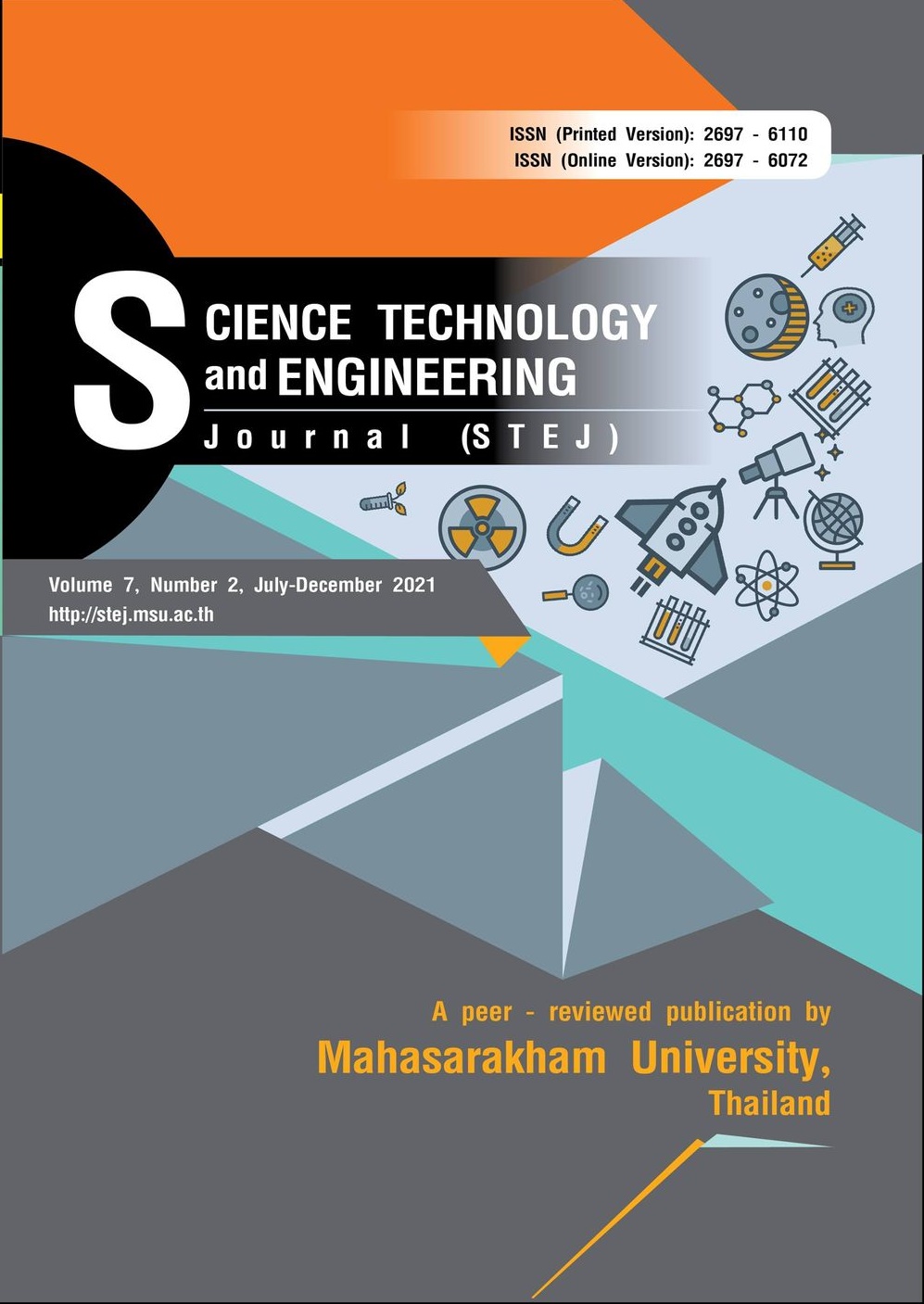Sequence Analysis of APOE Gene Across Mammalian Species in Thailand
Keywords:
Apolipoprotein E, mammals, polymorphismAbstract
The current study utilized five mammalian species, including rhesus monkey (Macaca mulatta), Thai Bangkaew dog (Canis lupus familiaris), Thai domestic cat (Felis catus), tiger (Panthera tigris) and Thai domestic rabbit (Oryctolagus cuniculus) to survey the prevalence of apolipoprotein E isoform distribution. Screening for the three common apolipoprotein E (APOE) isoforms (E2, E3 and E4) was achieved using APOE gene sequencing analysis. The results clearly revealed the homology of APOE protein sequences in analyzed mammals, ranging from 59.74 96.22% and 64.15-100% identity and similarity, respectively. Thai Bangkaew dog, Thai domestic cat, tiger, and rhesus monkey show arginine at the positions 112 and 158, which are found in APOE4 of human. This result demonstrates that for these five investigated mammals are apolipoprotein E4, and is associated with an increased genetic risk factor of both Alzheimer’s disease (AD) and coronary heart disease (CHD). Remarkably, Thai domestic rabbit has cysteine at position 112 and arginine at position 158. This indicates that the APOE isoform of Thai domestic rabbit is identical to that of human APOE3, and is not associated with the risk for Alzheimer’s disease. The evolutionary history inferred that Thai Bangkaew dog, Thai domestic cat and tiger are distinguishable as a group from Thai domestic rabbit, rhesus monkey and human by certain differences in amino acid sequences. This study provides valuable genetic resources for future study to identify potential biomarkers of neurodegenerative diseases in mammals using apolipoprotein E gene expression profiles.
References
Altschul, S.F., Gish, W., Miller, W., Myers, E.W. & Lipman, D.J. (1990) “Basic local alignment search tool. Journal of Molecular Biology, 215, 403-410.
Belloy, M.E., Napolioni, V. & Greicius, M.D. (2019). A Quarter Century of APOE and Alzheimer’s Disease: Progress to Date and the Path Forward. Neuron, 101 (5), 820-838.
Butterfield, D.A. & Halliwell, B. (2019). Oxidative stress, glucose dysmetabolism and Alzheimer disease. Nature Reviews Neuroscience,20 (3), 148-160.
Fainman, J., Eid, M.D., Ervin, F.R. & Palmour, R.M. (2007). A primate model for Alzheimer’s disease: Investigation of the apolipoprotein E profile of the vervet monkey of St. Kitts. American Journal of Medical Genetics Part B Neuropsychiatric Genetics, 144B (6), 818-819.
Frieden, C. & Garai, K. (2019). Concerning the structure of apoE. ProteiScience, 22 (12), 1820-1825.
Frieden, C. & Garai, K. (2012). Structural differences between apoE3 and apoE4 may be useful in developing therapeutic agents for Alzheim-er’s disease. Proceedings of the National Academy of Sciences 109 (23) (pp. 8913-8918). United states of America.
Gearing, M., Rebeck, G.W., Hyman, B. T., Tigges, J. & Mirra. S.S. (1994). Neuropathology and Apoliprotein E Profile of Aged Chimpanzees: Implications for Alzheimer Disease. Proceedings of the National Academy of Sciences 91(20) (pp. 9382-9386). United states of America.
Herz, J. & Beffert, U. (2021). Apolipoprotein E receptors: linking brain development and Alzheimer’s disease. Nature Reviews Neurosciences, 1(1), 51-58.
Huebbe, P. & Rimbach, G. (2021). Evolution of human apolipoprotein e (APOE) isoforms: Gene structure, protein function and interaction with dietary factors. Ageing Research Reviews, 37, 146-161.
Jones, D.T., Taylor, W.R. & Thornton, J.M. (1992). The rapid generation of mutation data matrices from protein sequences. Computer Applications in the Biosciences, 8, 275-282.
Kloske, C.M. & Wilcock, D.M. (2020). The important interface between apolipoproteinE and neuroinflammation in Alzheimer’s disease. Frontier in Immunology,11, 754.
Kumar, S., Stecher, G., Li M., Knyaz C. & Tamura, K. (2018). MEGA X: Molecular Evolutionary Genetics Analysis across computing platforms. Molecular Biology and Evolution, 35, 1547-1549.
Lauderback, C., Kanski, M.J., Hackett, J.M., Maeda, N., Kindy, M.S. & Butterf, D.A. (2002). Apolipoprotein E modulates Alzheimer’s Ab (1-42)-induced oxidativedamage to synaptosomes in an allele-specific manner. Brain Research, 924, 90-97.
McIntosh A.M., Bennett C., Dickson D., Anestis S.F., Watts D.P., Webster T.H., Babette, M.F. & Bradley, B.J. (2012). The apolipoprotein E (APOE) gene appears functionally monomorphic in chimpanzees (Pan troglodytes). PLoS ONE, 7 (10).
Muñoz, S.S., Garner, B. & Ooi, L. (2019). Understanding the Role of ApoE Fragments in Alzheimer’s Disease. Neurochemical Research, 44 (6), 1297-1305.
Pedersen, W.A., Chan, S.L. & Mattson, M.P. (2019). A mechanism for the neuroprotective effect of apolipoprotein E: isoform-specific modification by the lipid peroxidation product 4-hydroxynonenal. Journal of Neurochemistry, 74 (4), 1426-33.
Qian, J., Betensky, R.A., Hyman, B.T. & Pozo, A.-S. (2021). Association of APOE Genotype With Heterogeneity of Cognitive Decline Rate in Alzheimer Disease. Neurology, 96, e2414-e2428
Rech, P. (2008). SIAS: Sequence identities and similarities. http://imed.med.ucm.es/Tools/sias.html.
Safieh, M., Korczyn, A.D. & Michaelson, D.M. (2019). ApoE4: an emerging therapeutic target for Alzheimer’s disease. BMC Medicine, 17, 64.
Tachibana, M., Holm, M.-L., Liu, C.-C., Shinohara, M., Aikawa, T., Oue, H., Yamazaki,Y., Martens, Y.A., Murray, M.E., Sullivan, P.M., Weyer, K., Glerup, S., Dickson, D.W., Bu, G. & Takahisa Kanekiyo. (2019). APOE4-mediated amyloid-β pathology depends on its neuronal receptor LRP1. The Journal of Clinical Investigation,129 (3), 1272-1277.
Vasilevskaya, A., Taghdiri, F., Burke, C., Tarazi, A., Naeimi, S.A., Khodadadi, M,. Goswami, R., Sato, C., Grinberg, M., Moreno, D., Wennberg, R., Mikulis, D., Green, R., Colella, B., Davis, K.D., Rusjan, P., Houle, S., Tator, C., Rogaeva. E. & Tartagliaa, M.C. (2019). Interaction of APOE4 alleles and PET tau imaging in former contact sport athletes. NeuroImage: Clinical, 26, 102212.
Yamazaki, Y., Zhao, N., Caulfield, T.R., Liu, C.C. & Bu, G. (2019). Apolipoprotein E and Alzheimer disease: pathobiology and targeting strategies. Nature Reviews, 15 (9), 501-518.
Yassine, H.N. & Finch, C.E. (2019). APOE Alleles and Diet in Brain Aging and Alzheimer’s Disease. Frontiers in Aging Neuroscience, 10, 12-150.
Downloads
Published
How to Cite
Issue
Section
License
Copyright (c) 2021 Science Technology and Engineering Journal (STEJ)

This work is licensed under a Creative Commons Attribution-NoDerivatives 4.0 International License.







